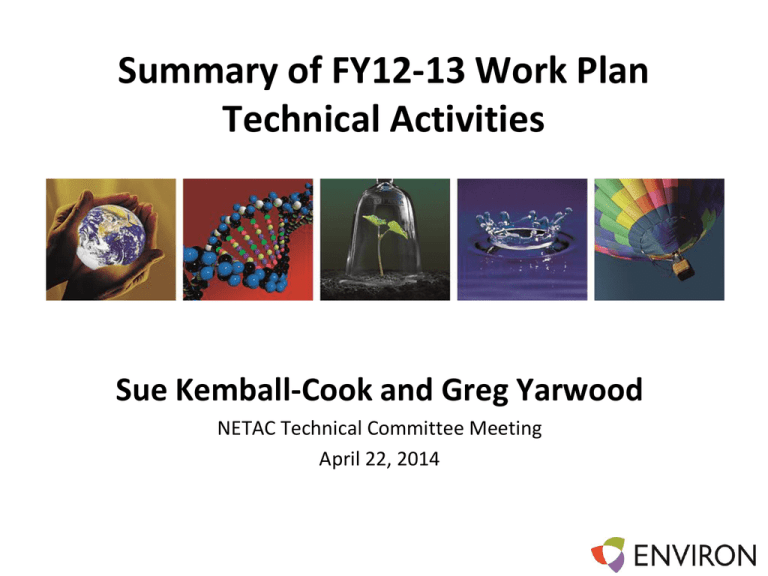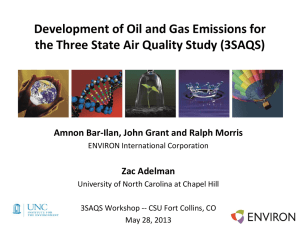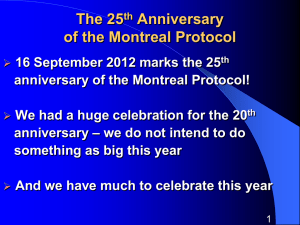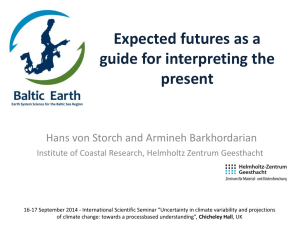FY 12-13 Technical Committee Reports
advertisement

Summary of FY12-13 Work Plan Technical Activities Sue Kemball-Cook and Greg Yarwood NETAC Technical Committee Meeting April 22, 2014 Template Today’s Presentation • Summary of FY12-13 work plan studies carried out since last NETAC meeting – – – – – Emission inventory Control strategy evaluation Haynesville Shale truck traffic study Ozone modeling Conceptual model update 2 Emission Inventory Review • Review most recent TCEQ inventories available for the 5-county area for off-road, area and point sources – EIs that may be used for ozone modeling or future inventory development • 2008 area, off-road EIs; 2006 point source EI – Identify emissions sources that are missing or not well-characterized – Comparison with other available emissions data – Point source emissions trend analysis 3 Recommendations • Develop area-specific gas compressor engine NOx emission inventory – Engine data in current TCEQ inventories drawn from Barnett Shale Not specific to Northeast Texas and unlikely to be good representation given differences in field ages, operations, formation depths and gas/liquid composition – Survey of compressor engine owner/operators similar to TCEQ’s Barnett Shale effort to gather engine population data needed for inventory development • Continue efforts to characterize Sabine Industrial District • • • HRVOCs Correct rail emission inventory Evaluate relationship between high ozone at CAMS 19 and Knox Lee power plant emissions Continue to monitor oil and gas development activity 4 Control Strategy Evaluation • Identify control measures that can reduce ozone precursor emissions in 5county area – Must meet the criteria for SIP credit (quantifiable, enforceable, surplus, and permanent) – Must be under local control – Based on previous NETAC studies, focus on NOx, HRVOCs 5 Identification of Control Measures • Reviewed air quality plans for other Texas regions to identify recently adopted measures • Outreach within NETAC area: – Letter to local government representatives Efforts to improve air quality through public awareness programs and innovative alternative programs such as energy efficiency – Letter to power plant and Sabine Industrial District operators Planned and/or potential controls at their facilities • Compiled list of possible control measures 6 Evaluation of Control Measures • Analyzed TCEQ inventories and 2011 NEI to determine the amount of emissions available for measure in each source category in 5-county area • For each measure: – Potential for reducing NOx emissions – Published estimates of the measure’s costeffectiveness • Compiled list of measures and ranked according to emissions benefit 7 Summary of Control Measures 8 Haynesville Shale Truck Traffic Study • Study characterized emissions from mobile sources in Haynesville Shale • NETAC’s Haynesville emission inventories developed in 2009 and updated in 2012 both focused on point and area source categories – Except for drilling rigs and portable hydraulic fracturing pumps, neither study estimated emissions from on-road and off-road mobile sources • Heavy-duty diesel trucks that transport water and materials to and from well sites may be an important source of NOx emissions • Trips can occur on rural public roads and on private roads – Likely that these trips not fully accounted for in current on-road mobile source inventories 9 Method • Distributed surveys to the major Haynesville producers – Truck trips, types of vehicles being used, trip distance, roadway types, equipment HP and tier level, etc. – Only one survey response received • Supplemented survey data with literature review • Developed emission inventory for 2012 – Per spud or per well vehicle and off-road equipment activity – Emissions factors from MOVES and NONROAD 10 Haynesville Mobile Source Emissions • NOx emissions from Haynesville mobile sources (including truck traffic) were 4 tpd, which is 12% of the total Haynesville NOx inventory – On-road NOx emissions evenly divided between driving and idling • 3% of the total Haynesville mobile, point and area source VOC inventory 11 Recommendations for Future Work • Only one survey response received; inventory is therefore highly uncertain – Improving inventory requires data from Haynesville Shale operators • Develop a method to reconcile the Haynesville mobile source activity and emissions with the TCEQ’s existing state-wide mobile source inventory • Deploy traffic counters on rural roadways in the Haynesville region in order to gather vehicle counts and vehicle type classification data 12 Ozone Modeling • Model development for 2005 and 2006 episodes – Improved model performance due to revised chemical mechanism, CB6r2 • Sensitivity of modeled ozone to Sabine Industrial District HRVOC emissions • Ozone impacts of emissions from natural gas development in the Haynesville Shale • Ozone impacts of changes in anthropogenic emissions between 2006 and 2012 13 Changes to the Model • New TCEQ continental-scale modeling grid • TCEQ provided additional days of inputs for spinup period • Emissions – TCEQ EI Update – ENVIRON added lightning NOx, TCEQ aircraft cruise emissions, and day-specific wildfire emissions • Increased vertical transport within clouds • New CAMx version v6.00 – Revisions to Plume-in-Grid model that treats plumes from large NOx sources • Update to chemical mechanism, CB6r2, based on Texas AQRP • Project results Most important change was use of CB6r2, which reduced ozone regionally and improved model performance 14 2006 Model Performance Evaluation: Longview • High bias significantly reduced in new run (blue) 15 2006 Model Performance Evaluation: Karnack • High bias reduced in new run but still significant, especially for monitors on the Texas border 16 2005 Model Performance Evaluation: Longview • High bias significantly reduced in new run (blue) • Dramatic overestimates caused by spurious local power plant plume impacts (May 29) • Evaluation and improvement of meteorology required 17 Emissions Sensitivity Test: HRVOCs in the Sabine Industrial District • SOF sampling downwind of the SID measured emissions larger • than those reported to the STARS database a factor of ~2 for ethylene and a ~6 for propylene Emissions sensitivity test of ozone impacts of this underestimate • Added virtual nearsurface point source emitting HRVOCs – Room temperature – Little vertical plume rise Sabine Industrial Complex Measured Typical 2006 TCEQ EI Emissions Ethylene and Propylene Emissions SOF (Typical) Species grams/day tons/day tons/day ethylene 4,472,802 4.9 5.4 propylene 1,094,113 1.2 4.6 Sabine Virtual Source Emissions tons/day 0.5 3.4 18 Sabine Test: 8-hour Ozone Impacts • 8-hour impacts averaged over the episode are relatively modest, with peak value of 0.5 ppb • Episode maximum 8-hour impacts are larger and more widespread ( peak of 2.4 ppb) with impacts ranging from 0.2-0.6 ppb near the monitors • Test shows 8-hour ozone impacts of the SID are currently underestimated by as much as 2.5 ppb in NETAC’s ozone modeling 19 TCEQ 2012 Emission Inventory • 2012 anthropogenic emission inventory used for the State of Texas Ozone Forecasting System developed by ENVIRON and the TCEQ • Typical June day • 2012 summer quarter hourly average emissions for power plants, STARS ozone season data for other Texas points • EPA MOVES model for on-road mobile emissions • Oil and gas based on 2011 year and projected to 2012 20 TCEQ 2006 and 2012 5-County Area Anthropogenic NOx Emissions • Large overall NOx emissions reductions • On-road and off-road emissions reduced due to fleet turnover to cleaner engines • Reduction in oil and gas emissions, despite well count increase 21 TCEQ 2006 and 2012 5-County Area Anthropogenic VOC Emissions • Largest emissions reductions in oil and gas category • Biogenic VOC emissions are much larger than anthropogenic VOC emissions 22 Local vs. Transported Contribution Northeast Texas Ozone • Transport far larger than local contribution using both 2006 and 2012 emissions • Both local and transported contribution decrease with 2012 emissions relative to 2006 23 Haynesville Shale Ozone Impacts Updated Emissions 2006 Meteorology Monitor CAMS ID Gregg County Smith County Harrison County C19 C82 C85 2011-2013 Design Value (ppb) 77 75 72 Original Emissions 2005 Meteorology Haynesville Shale Contribution to DV (ppb) 1.5 0.9 1 • Impacts smaller using updated emission inventory – Incorporating data from operators reduced emissions estimates • Haynesville emission can influence Northeast Texas monitor attainment of NAAQS 24 Haynesville Mobile Source Emission Ozone Impacts • Haynesville mobile source impacts are large enough that it is important to include this component of the inventory 25 Ozone Modeling Summary • New CB6r2 chemical mechanism improves ozone performance significantly, although high bias remains – High bias most pronounced on eastern border of Texas • TCEQ emission inventory for 2012 shows large decreases relative to 2006 – Emissions reductions lower ozone levels in Northeast Texas and in transported background – Important to understand TCEQ 2012 inventory and evaluate in a 2012 episode (i.e. 2012 weather) – TCEQ is adding new 2006 episode; 2012 episode not expected during this biennium • Haynesville impacts of updated inventory smaller than those of • original inventory, but still significant Emission sensitivity tests show 8-hour ozone impacts of Sabine Industrial District emissions currently underestimated in NETAC’s ozone modeling 26 Conceptual Model Update • Summary of ozone trends • • • June 27, 2012: Fires and Back Trajectories • and attainment status Emissions trends Oil and gas activity trends Updated ambient data analyses High ozone day analysis – Evaluation of possible fire impacts on high ozone days • Summary of ozone modeling • Updated conceptual model confirms data continue to be consistent with prior understanding 27 End 28








